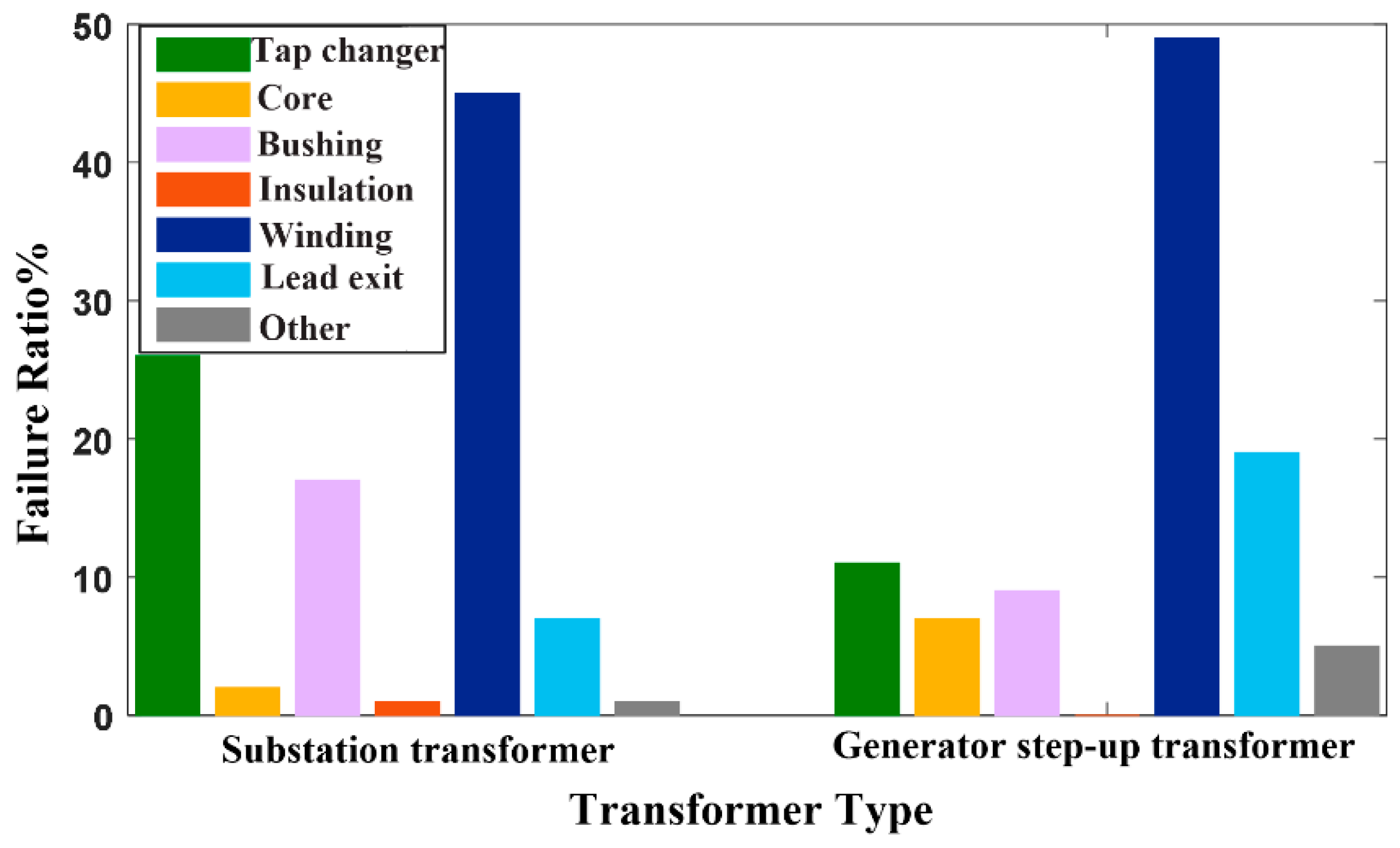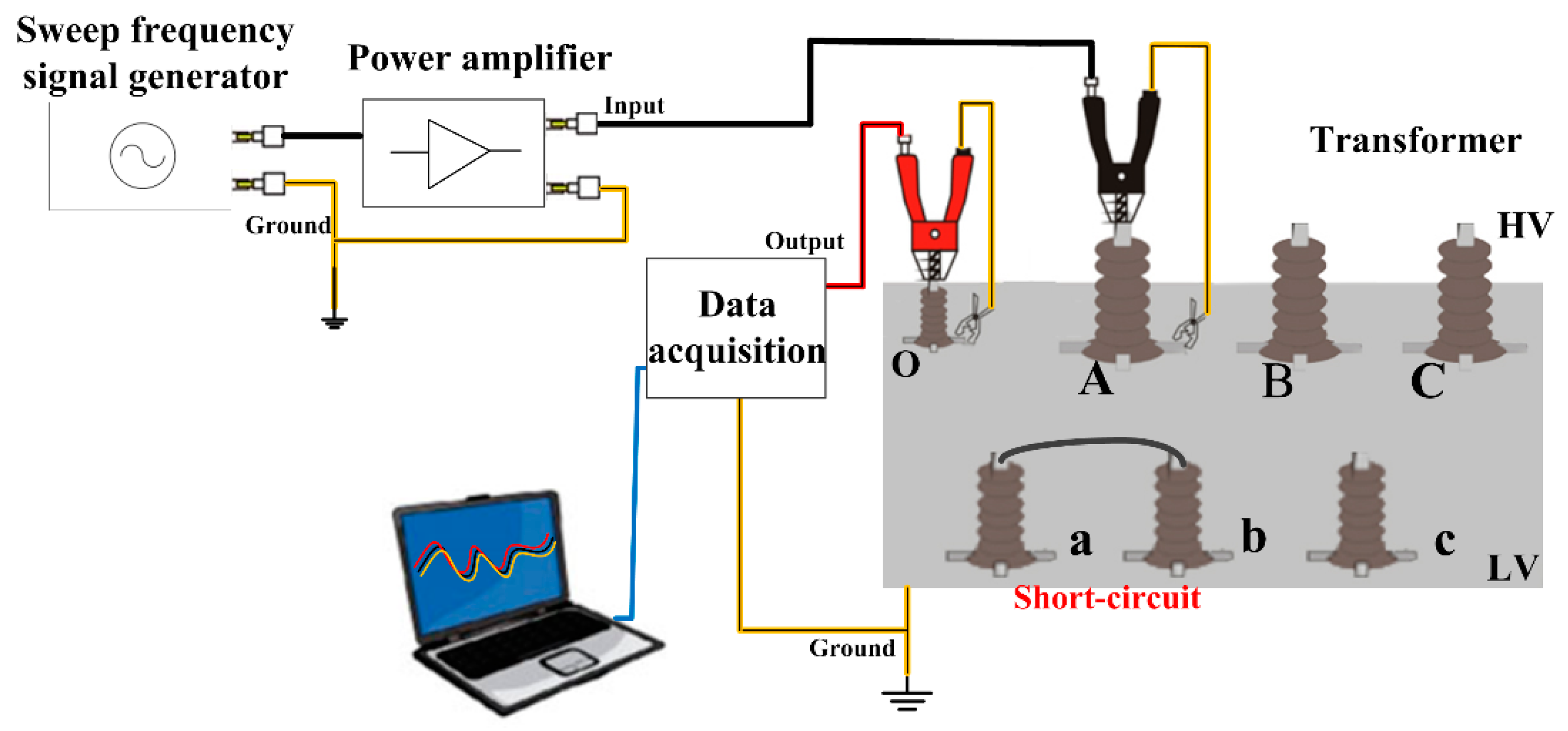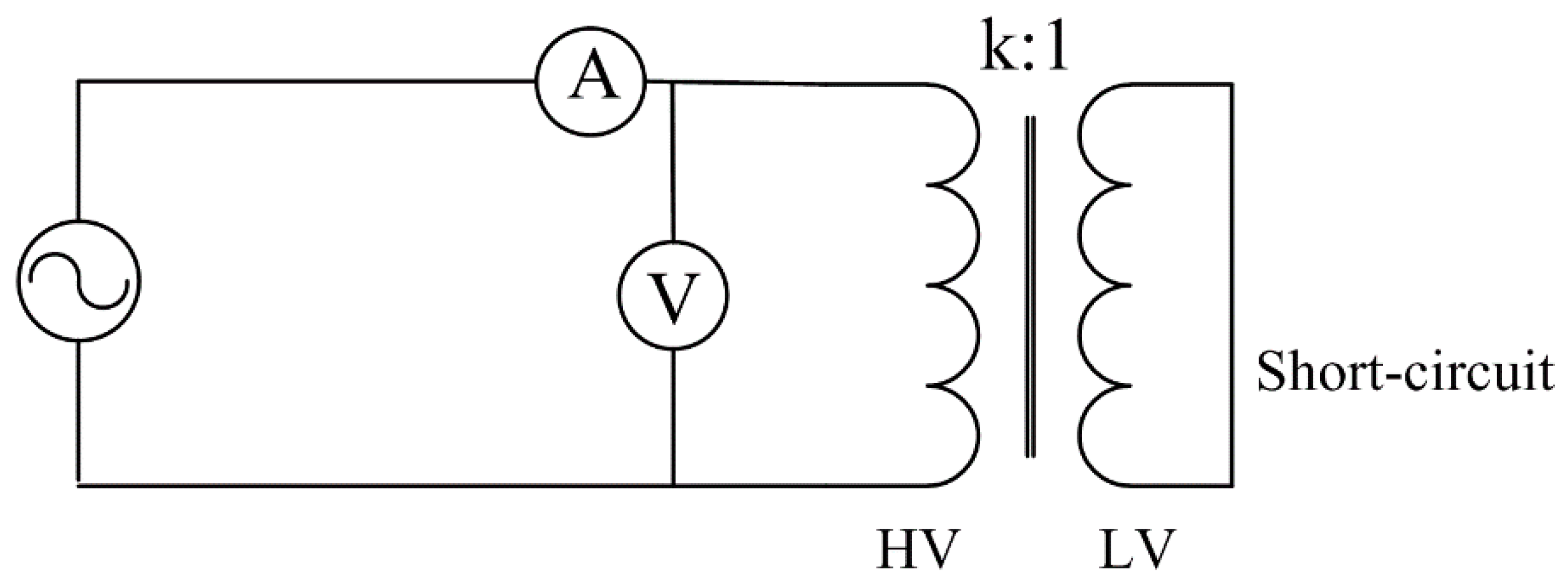3.2. Results Analysis of the SFI Measurement
According to the measurement principle of the SFI method, it can be known that SFI measurements should be conducted on the HV winding with the LV winding shorted. For this transformer, because voltages of the HV and MV windings are both larger than that of the LV winding and voltage of HV winding is also larger than that of the MV winding, so there will be three different SFI measurement modes for this experimental transformer, i.e., “HV to MV”, “MV to LV”, and “HV to LV”. It is “HV to MV” mode when the HV winding is measured with MV winding shorted. To clearly explain the “HV-MV”, “MV-LV”, and “HV-LV” measurement connections, the schematic diagram of “HV to LV”, “MV to LV”, and “HV-LV” modes is presented in
Figure 6.
As SFI measurements have not been conducted on this transformer before, there is no original SFI reference data. Therefore, the comparison of the SFI test results can be made between the phases due to the symmetry. This comparison way is called construction-based method and it is suggested by [
18]. The SFI curves of three phases of the transformer winding under the three modes are shown in
Figure 7,
Figure 8 and
Figure 9, respectively. At the same time, to accurately analyze the variations of the SFI curves, the numerical index
RF used in FRA field is applied. The calculated values of
RF for the phases under three modes are, respectively, shown in
Table 2,
Table 3 and
Table 4. The detailed calculation equations of the
RF and relationship between deformation degree and the corresponding values of
RF are given in
Appendix A.
Here, the
RF of the SFI curve under different modes and the percentage impedance results obtained from the SFI test will be comprehensively analyzed to determine the deformation of the winding. In
Figure 7, the SFI curves of phase A and phase C under “HV-MV” mode have good consistency in the whole frequency range. Additionally, in
Table 2, the values of
RFCA in the low frequency (LF), medium frequency (MF), and high frequency (HF) ranges all satisfy the
RF values of the normal winding according to the relationship between deformation degree and the values of
RF in
Table A1. The above results indicate that HV or LV winding of phase A and phase C may be healthy. Differently, the SFI results of phase B at low frequencies from 10 Hz to 9 kHz in
Figure 6 are larger than that of the other two phases and the values of
RFAB and
RFBC in the LF and MF ranges all conform to the
RF values of the moderate deformation. It means that HV or MV winding of phase B may be faulty.
To obtain the accurate diagnosis results, the SFI curves in
Figure 8 and
Figure 9 and the values of
RF under “MV-LV” and “HV-LV” modes in
Table 3 and
Table 4 are deeply analyzed. In
Figure 8, the SFI curves of phase A under “MV to LV” mode is also in good agreement with those of phase C, which is similar to the SFI curves of phases A and C in
Figure 7. Additionally, the values of
RFCA in the whole frequency range show the MV or LV windings of phases A and C are healthy. However, the SFI curve of phase B under “MV to LV” mode shows a big difference from the SFI results of phase A and phase C. Especially, the changing trend of this SFI curve from 10 Hz to 40 kHz is opposite to those of phase A and phase C and the impedance values of phase B in this range are extremely large. The values of
RFAB and
RFBC in the whole frequency range are very small and they indicate that severe failure may occur in MV or LV windings of phases A, B, and C. However, since MV or LV windings of phases A and C are healthy, only MV or LV winding of phase B seems to be faulty.
According to the results in
Figure 9 and
Table 4, it can be easily seen that all the SFI curves of three phases under “HV to LV” mode are in good agreement with each other and the values of
RF are normal. Hence, it shows that HV and LV windings of three phases are all healthy. At this point, summarizing the above analysis results, it can be obtained that HV and LV windings of three phases and MV windings of phase A and phase C are healthy, but MV winding of phase B deforms severely.
In addition to the SFI curves, the SFI value at power frequency simultaneously measured by the SFI test also can be used to further determine the fault. The comparison of the percentage impedance at power frequency obtained from the SFI test and the nameplate are given in
Table 5. The deviation of the percentage impedance of “HV to LV” at power frequency measured by the SFI test is close to that obtained from the nameplate. It shows that the HV and LV winding are healthy. However, the deviations of the percentage impedance of “HV to MV” and “MV to LV” at power frequency are 62.42% and 176.09%, respectively, which are much larger than the maximum permitted change value (3%). Combining our judgment on the state of HV and LV windings, we can get that only MV winding faults occur. This diagnostic result is similar to the result obtained through analysis of the SFI curve.
Finally, based on the changing law of the SFI curve under “HV to MV” and “MV to LV” modes and the significantly increased percentage impedances of “HV to MV” and “MV to LV” at power frequency, we can determine that an open-circuit fault occurs in the MV winding of phase B. The reason is given through analysis of the simplified equivalent circuit of the transformer, as shown in
Figure 10. For the SFI test under “HV to MV” mode, when the MV winding of phase B is open-circuit, the SCI of the winding mainly depends on the magnetizing inductance
Lm and resistance
Rm, which are much larger than the reduction inductance
L2e and resistance
R2e of the MV winding from the HV side. Therefore, the percentage impedance of “HV to MV” measured by SFI test is larger than the normal value in the nameplate. For the SFI test under “MV to LV” mode, when the MV winding of phase B is open-circuit, the output voltage measured from one terminal of the MV winding will be a very small inductive voltage and it will increase with the increasing of the frequency. Therefore, according to the relationship between the impedance and the input/output voltage expressed in Equation (3), the SFI value greatly increases and the SFI curve in
Figure 8 shows a very different changing trend at 10 Hz to 10 kHz.














